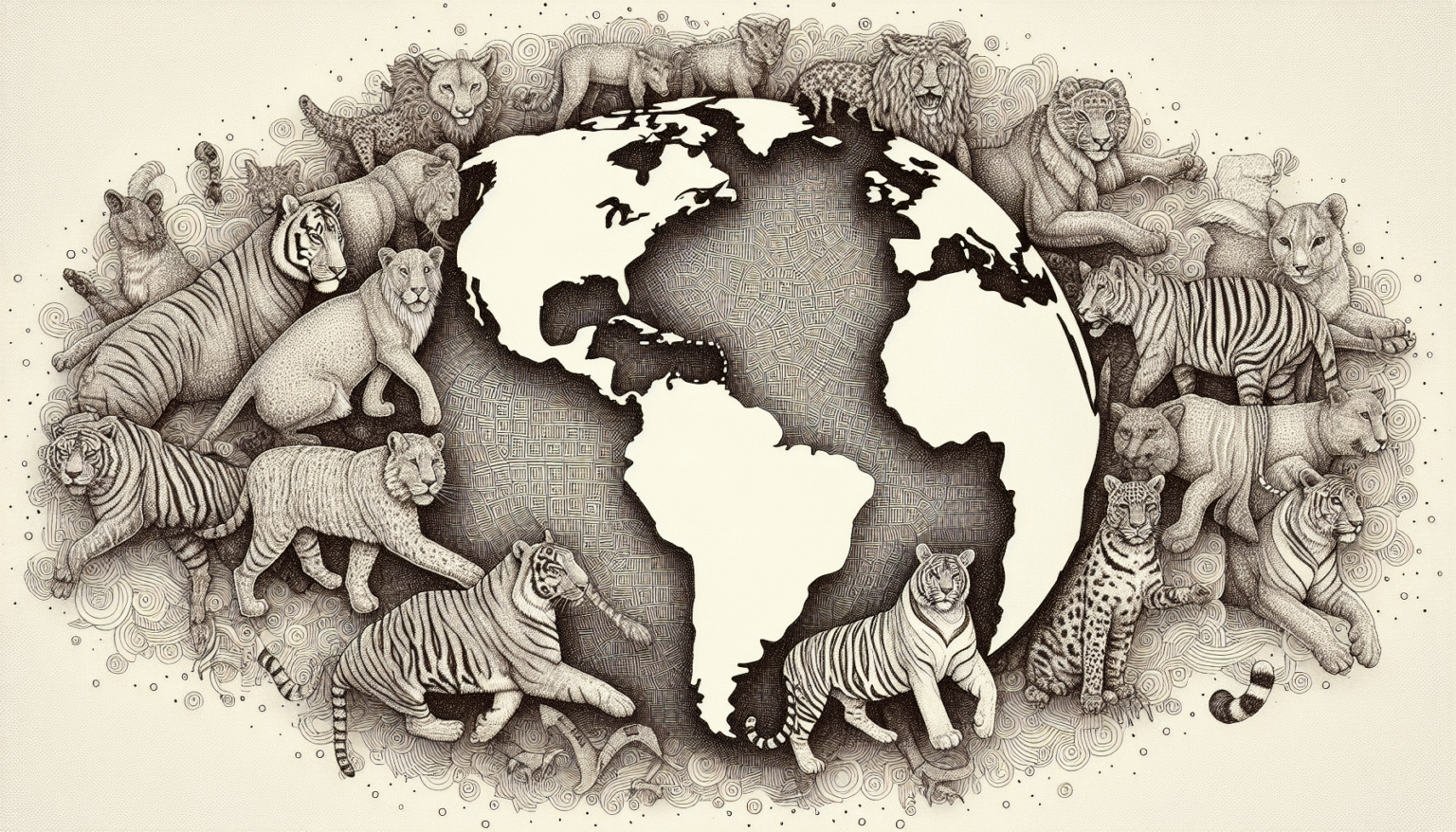Tulum: A Catalyst for International Big Cat Preservation
1. The Tulum Ecosystem
Nestled along Mexico’s Caribbean coast, Tulum is more than just a picturesque destination. Its diverse ecosystem, characterized by tropical forests, wetlands, and expansive coastlines, serves as a crucial habitat for various species, including big cats like the jaguar and the ocelot. The region’s biodiversity is vital to the sustenance of the world’s second-largest barrier reef, contributing to its crucial role in maintaining ecological balance and protecting vulnerable species.
2. Importance of Big Cats
Big cats are apex predators, playing an essential role in maintaining the health of ecosystems. They control prey populations, which in turn sustains vegetation and fosters biodiversity. Predators like the jaguar, the largest cat in the Americas, are crucial for ecosystems, such as the jungles of the Yucatán Peninsula. The survival of these magnificent creatures is not only significant for biodiversity but also for cultural heritage and tourism, contributing heavily to local economies.
3. Conservation Organizations in Tulum
Tulum is becoming a hub for conservation efforts aimed at preserving big cats and their habitats. Notable organizations, such as the Panthera Corporation and Mexican Nature Conservation Fund, focus on research, education, and grassroots initiatives to boost awareness and foster protective legislation. These organizations collaborate with federal and international bodies to develop extensive research programs that monitor big cat populations and their habitats.
4. Community Involvement
Community engagement plays a critical role in conservation. Local communities in Tulum are increasingly involved in initiatives designed to preserve big cats. Programs educating residents about the ecological importance of these big felines foster community stewardship. Efforts such as wildlife tourism and eco-tours provide alternative livelihoods and give locals a vested interest in protecting these animals.
5. Ecotourism’s Role
Ecotourism has become a focal point in Tulum, where visitors have the opportunity to observe wildlife in their natural habitats. Sustainable travel initiatives promote responsible tourism that reduces human-wildlife conflict. Guided tours emphasize wildlife conservation and educate tourists about the significance of big cats in maintaining ecological balance, thereby generating funds for conservation projects while cultivating respect and awareness.
6. Legislative Framework and Advocacy
Tulum’s local government has been proactive in implementing policies that protect wildlife. Advocacy efforts from NGOs and environmental groups help shape legislation aimed at protecting big cats’ natural habitats. Collaborative projects targeting illegal poaching and habitat destruction have seen success due to more stringent laws and increased enforcement of existing regulations.
7. Research and Data Collection
Research initiatives in Tulum focus on monitoring big cat populations and their health. Camera traps and GPS collaring methods have proven effective in studying movement patterns, population dynamics, and habitat utilization. Collaboration with academic institutions has led to significant findings regarding the species’ conservation requirements, ensuring that local conservation strategies are based on solid scientific evidence.
8. Climate Change Impacts
Climate change poses significant threats to big cats and their habitats. Rising temperatures, changing rainfall patterns, and habitat fragmentation complicate their survival. Tulum’s organizations focus on broader climate adaptation strategies that protect not only big cats but also the entire ecosystem. Advocacy for sustainable land use and preservation of green corridors is vital in combating the adverse effects of climate change.
9. Cultural Significance of Big Cats
Big cats hold enormous cultural significance in the indigenous lore of the region. The jaguar, for instance, is often emblematic of power and strength, appearing in mythology across various Latin American cultures. This intrinsic cultural value adds layers to conservation initiatives when community narratives are intertwined with nature conservation efforts, fostering a deeper connection between the local populace and the wildlife.
10. Educational Initiatives
Educational programs in Tulum aim to raise awareness about big cat conservation. Schools and community organizations conduct workshops, outreach programs, and wildlife fairs to engage the public. Such initiatives cultivate environmental consciousness among youth and emphasize the importance of preserving biodiversity for future generations.
11. Success Stories
Tulum’s collaborative conservation model has yielded positive results. Successful breeding programs for jaguars and ocelots have led to population growth in specific protected areas. Local engagement and international funding have further fortified these successes, demonstrating the potential for meaningful impacts through cooperative efforts.
12. Challenges Ahead
Despite the progress, Tulum faces considerable challenges. Habitat encroachment due to development and tourism pressures continues to threaten big cats. Continuous efforts are required not only to uphold protections in the face of economic development but also to educate stakeholders on sustainable practices that balance interests.
13. Role of Technology in Conservation
Advancements in technology have transformed conservation strategies. Drones, satellite imaging, and AI-powered data analysis play significant roles in monitoring habitats and identifying illegal activities. In Tulum, using cutting-edge technology assists in real-time tracking of wildlife, ensuring both the safety of big cats and robust data collection for research purposes.
14. Partnerships with Global Organizations
Tulum has established partnerships with global organizations like the World Wildlife Fund (WWF) and Wildlife Conservation Society (WCS). These collaborations focus on international standards and best practices for wildlife protection. Financial and technical support from these entities amplifies local conservation efforts, enhancing the credibility and outreach of Tulum’s initiatives.
15. Future Prospects
Looking ahead, Tulum’s commitment to international big cat preservation remains unwavering. Engaging local communities, harnessing technology, and forming robust partnerships will look to safeguard the habitats of these majestic creatures. A concerted effort to educate and involve stakeholders is pivotal in transforming Tulum into a model for global biodiversity preservation.
By focusing on local engagement, legislative advocacy, and innovative conservation efforts, Tulum emerges as a vital player on the international stage for big cat preservation, illustrating how interconnected ecosystems thrive through collective commitment and action.







